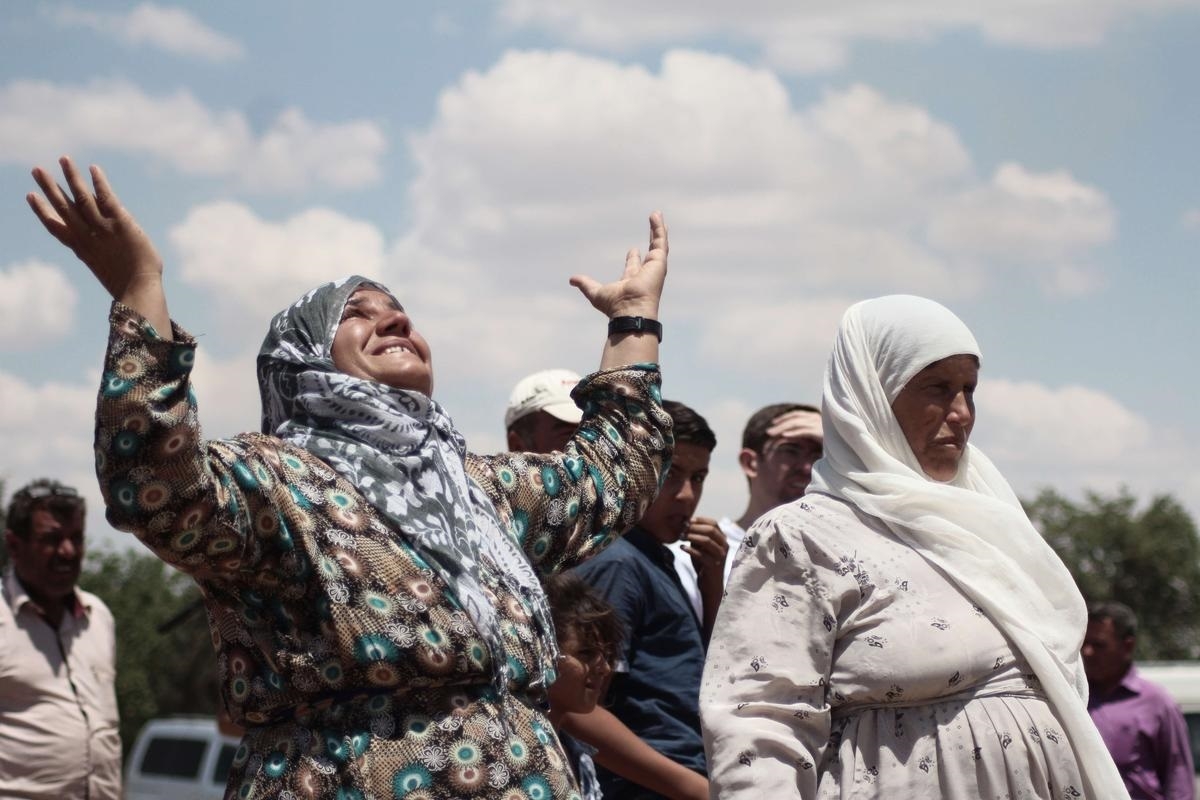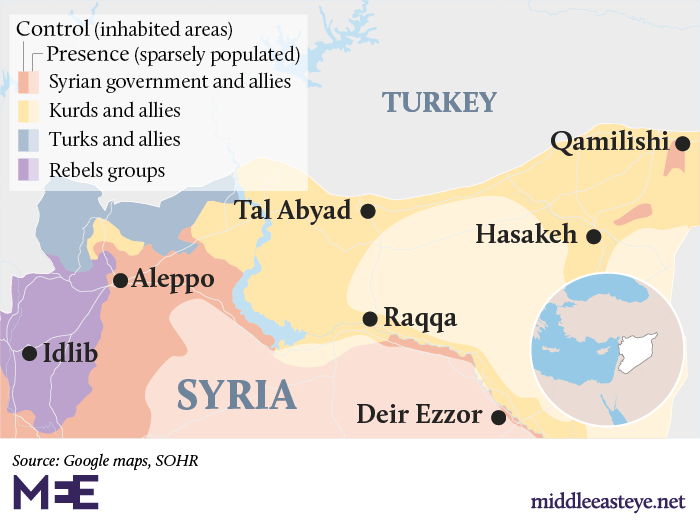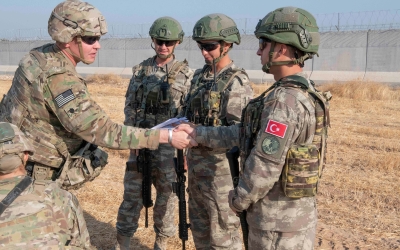'If we stay here, will we die?' Residents brace for Turkish offensive on Syrian border

Over a long, tense night of tea and bizr seeds, neighbours Anwar al-Haddar and Muhammad Yaseen followed the news religiously on their mobile phones, and talked nervously about the coming days.
Their home city, Ras al-Ain, sits along Syria's northeastern border with Turkey, an area heavily populated by Syrian Kurds as well as Arabs and a number of minority groups.
The city is also a likely epicentre for what could soon be a major military offensive by Turkey, after US troops suddenly began withdrawing from northern Syria on Monday, abandoning allied majority-Kurdish Syrian Democratic Forces (SDF) in charge there.
Ankara has long spoken of setting up a "safe zone" stretching along the border in parts of northeastern Syria under the control of the SDF, which Turkey sees as connected to the outlawed Kurdistan Workers’ Party (PKK).
Now is Ankara’s chance to set up that "safe zone" residents fear.
Reports of Turkish-backed forces massing on the other side of the border had already begun circulating on social media by Tuesday evening.
Turkish shells were said to have hit one SDF point near Ras al-Ain late Tuesday, according to an SDF tweet.
Fahretin Altun, the Turkish president's communications director, later wrote that Turkish forces would cross into SDF-held territory "shortly".
"We're just staying up late - we're afraid of what might happen," Haddar told Middle East Eye by phone on Tuesday night.
"There's nothing else we can really do," Yaseen said, taking the phone from his friend.
The two neighbours insisted they will stay in Ras al-Ain if the widely anticipated Turkish assault happens.
The men simply have no other place to go. Neither of them have relatives who can host them long-term elsewhere in SDF-held territory, and both say they are fearful of arrest or mandatory military conscription if they go further south into zones under the Syrian government’s control.
But people have reportedly already begun streaming out of the city, as well as other areas along the hundreds of kilometres of borderline between Turkey and SDF-controlled northeastern Syria.
Families flee
Up to several thousand Syrians have packed up their belongings and fled from their hometowns on the border since Monday, local sources told MEE, though some said it was unclear yet exactly how many people had left their homes.
In Tal Abyad, a border city some 100km west of Ras al-Ain, 300 families had already left, according to one source there with knowledge of the situation.
He requested anonymity for security reasons, as his own family members had fled the city for Syrian government-held territory near Raqqa.
"Many more [than those 300 families] have left Kobane," another nearby border city, said Ahmad Ramadan, head of the activist-run Euphrates Post news group based in Turkey. He could not provide a precise count.
One activist and former resident of Tal Abyad told MEE most of his family members still in the city had fled by Monday, "as soon as [the] US withdrawal happened".
Other relatives had been prevented from leaving the city, they told him, blocked by SDF-run checkpoints.
Residents said most of those who had fled were staying with friends and relatives in the outlying countryside.
Their flight comes as international organisations warn of a pending humanitarian crisis should Ankara go through with its anticipated attack.
Turkey's incursion could "displace hundreds of thousands of civilians across an area already in the grip of a humanitarian crisis," Refugees International President Eric Schwartz said on Tuesday.
The International Rescue Committee meanwhile warned some 300,000 people could be displaced by the offensive.
'Long-planned operation'
Concerns grew last month over Turkish President Recep Tayyip Erdogan's proposal to set up the so-called “safe-zone” in northeastern Syria, a plan he outlined at the UN General Assembly in New York.
The zone would stretch across hundreds of kilometres of the border, and reach 30km deep into Syrian territory.
Erdogan hopes to resettle as many as two million Syrian refugees currently living in Turkey in the area, he said at the time.
The president had threatened unilateral military action if the safe zone was not in place by the end of September.
The Trump administration effectively gave Turkish forces a green light for such action late on Sunday night, when the White House released a surprise statement announcing that Ankara would “soon be moving forward with its long-planned operation into Northern Syria”.
US troops would "no longer be in the area," according to the press release.
The announcement sent shockwaves through northeastern Syria.
SDF stunned
By Monday, US military vehicles were seen withdrawing from positions in the area, in effect leaving SDF forces to face the expected Turkish incursion alone.
The sudden exit stunned the SDF, long the US's staunchest military ally in Syria and its main partner in a years-long fight against Islamic State (IS).
Mustafa Bali, the SDF’s head spokesperson, called the withdrawal a "failure of US to fulfil their commitments," later posting an appeal for international aid that warned of a “humanitarian catastrophe” along border areas with Turkey.
The US withdrawal also ignited fears that IS prisoners held by the SDF in northeastern Syria could overrun their captors.
What exactly a Turkish military incursion could look like on the ground is so far unclear, analysts say.
Elizabeth Tsurkov, a fellow at the Foreign Policy Research Institute with contacts among Turkish-backed forces gearing up for the fight, said by Tuesday night "we don't know [yet] the extent of the offensive," though military action could initially be limited to Tal Abyad and Ras al-Ain, two points that US troops had evacuated by Tuesday.
Regardless of the potential scale of the attack, "any kind of incursion [would] upset the balance that currently exists in the northeast," Jasmine El-Gamal, a senior fellow at the Atlantic Council told MEE on Tuesday.
"You have a lot of issues that the SDF and local population are already dealing with," Gamal said.
"You have IDPs, you have the al-Hol camp, a lack of services, tensions between local tribes and some components of the SDF."
'Has Trump said anything new?'
In Kobane, 22-year-old Diana Ayoub waited out Tuesday night at home, with her husband and mother, tense.
A former journalist, she now stays in the house most of the time, pregnant with her first child.
The past two days had been filled with anxious conversations between neighbours, family members and friends, she said by phone.
“You run into someone, and the first thing they ask you is 'What will happen to us?'"
"The second thing: 'Has Trump said anything new? Is Erdogan issuing any threats? Will we flee? If we stay here, will we die?'"
There was a sense of tension outside, she said, the streets largely quiet as residents stayed home. "The market has been mostly empty," Ayoub said.
A neighbour burst into Ayoub’s home on Monday in frantic tears after news spread of the impending US troop withdrawal.
She asked Ayoub for a spare suitcase, to pack her children's belongings in case she needed to flee.
Unsure how to respond to the outburst, Ayoub simply laughed, she recalls.
"I didn’t know what to tell her," she said. Ayoub has no plans to leave home yet.
For Anwar in Ras al-Ain, who spent Tuesday night checking the news at his neighbour's house, the expected Turkish offensive has shattered a sense of relative calm.
Two of his cousins and a neighbour have already fled deeper into the surrounding countryside, away from the border area.
"To be honest, we wanted the US forces to stay - we felt safe with them here," he said. "Their exit has caused this fear."
Additional reporting by Noura al-Hourani
Middle East Eye propose une couverture et une analyse indépendantes et incomparables du Moyen-Orient, de l’Afrique du Nord et d’autres régions du monde. Pour en savoir plus sur la reprise de ce contenu et les frais qui s’appliquent, veuillez remplir ce formulaire [en anglais]. Pour en savoir plus sur MEE, cliquez ici [en anglais].








